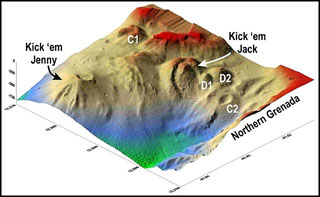Report on Kick 'em Jenny (Grenada) — May 1989
Scientific Event Alert Network Bulletin, vol. 14, no. 5 (May 1989)
Managing Editor: Lindsay McClelland.
Kick 'em Jenny (Grenada) Dives reveal 1988 pyroclastics, crater changes
Please cite this report as:
Global Volcanism Program, 1989. Report on Kick 'em Jenny (Grenada) (McClelland, L., ed.). Scientific Event Alert Network Bulletin, 14:5. Smithsonian Institution. https://doi.org/10.5479/si.GVP.SEAN198905-360160
Kick 'em Jenny
Grenada
12.3°N, 61.64°W; summit elev. -185 m
All times are local (unless otherwise noted)
Oceanographers in the submersible Johnson Sea-Link observed Kick-'em-Jenny on 15-16 April and 15-16 May, detecting substantial changes in its morphology since surveys in 1978. Most of the large dome-shaped mass that had nearly filled the crater in 1978 was gone in April-May 1989, and the crater had been breached to the E, probably by the December 1988 eruption (13:12). Three lithologies were seen around the crater rim: remnants of the former dome; an apparent explosion breccia composed of blocks from the dome and coarse ballistic material; and a fine-grained pyroclastic deposit, probably a pyroclastic flow, that extended outward from the breach and included some larger matrix-supported blocks. The pyroclastic deposit appeared to be the youngest of the three lithologies, with no ballistic material evident on its surface. The internal structure exposed in the remnants of the basaltic andesite dome consisted of sub-vertical, blade-like dikes radiating from a central lava source, very similar to features observed in the dome that grew in the crater lake at Soufrière of St. Vincent in 1971. No clear examples of pillow lavas were seen at either dome.
During the mid-April dives, strong upwelling was occurring from the crater. Bacterial mats several centimeters thick coated the pyroclastic deposit, and numerous dead crabs, shrimp, and fish suggested an anoxic environment at the volcano. By mid-May, the upwelling had stopped, the bacterial mats were breaking up, colonies of polychaete worms were present, and normal fish life was returning.
There had been no initial reports of surface disturbance associated with the December 1988 eruption. However, Michael Forshaw, harbormaster at St. George's, Grenada, reported that boats sailing to Carriacou in late December had returned to Grenada after encountering turbulent discolored water near the volcano. No precise dates were available for the observations.
Further Reference. Devine, J.D., and Sigurdsson, H., 1995, Petrology and eruption styles of Kick'em-Jenny submarine volcano, Lesser Antilles Arc: J. Volcanol. Geotherm. Res., v. 69, p. 35-58.
Geological Summary. Kick 'em Jenny, an active submarine volcano 8 km off the N shore of Grenada, rises 1,300 m from the sea floor. Recent bathymetric surveys have shown evidence for a major arcuate collapse structure, which was the source of a submarine debris avalanche that traveled more than 15 km W. Bathymetry also revealed another submarine cone to the SE, Kick 'em Jack, and submarine lava domes to its S. These and subaerial tuff rings and lava flows at Ile de Caille and other nearby islands may represent a single large volcanic complex. Numerous eruptions have occurred since 1939, mostly documented by acoustic signals. Prior to the 1939 eruption, when an eruption cloud rose 275 m above the ocean and was witnessed by a large number of people in northern Grenada, there had been no written mention of the volcano. Eruptions have involved both explosive activity and the quiet extrusion of lava flows and lava domes in the summit crater; deep rumbling noises have sometimes been heard onshore. Recent eruptions have modified the morphology of the summit crater.
Information Contacts: H. Sigurdsson, Univ of Rhode Island.

